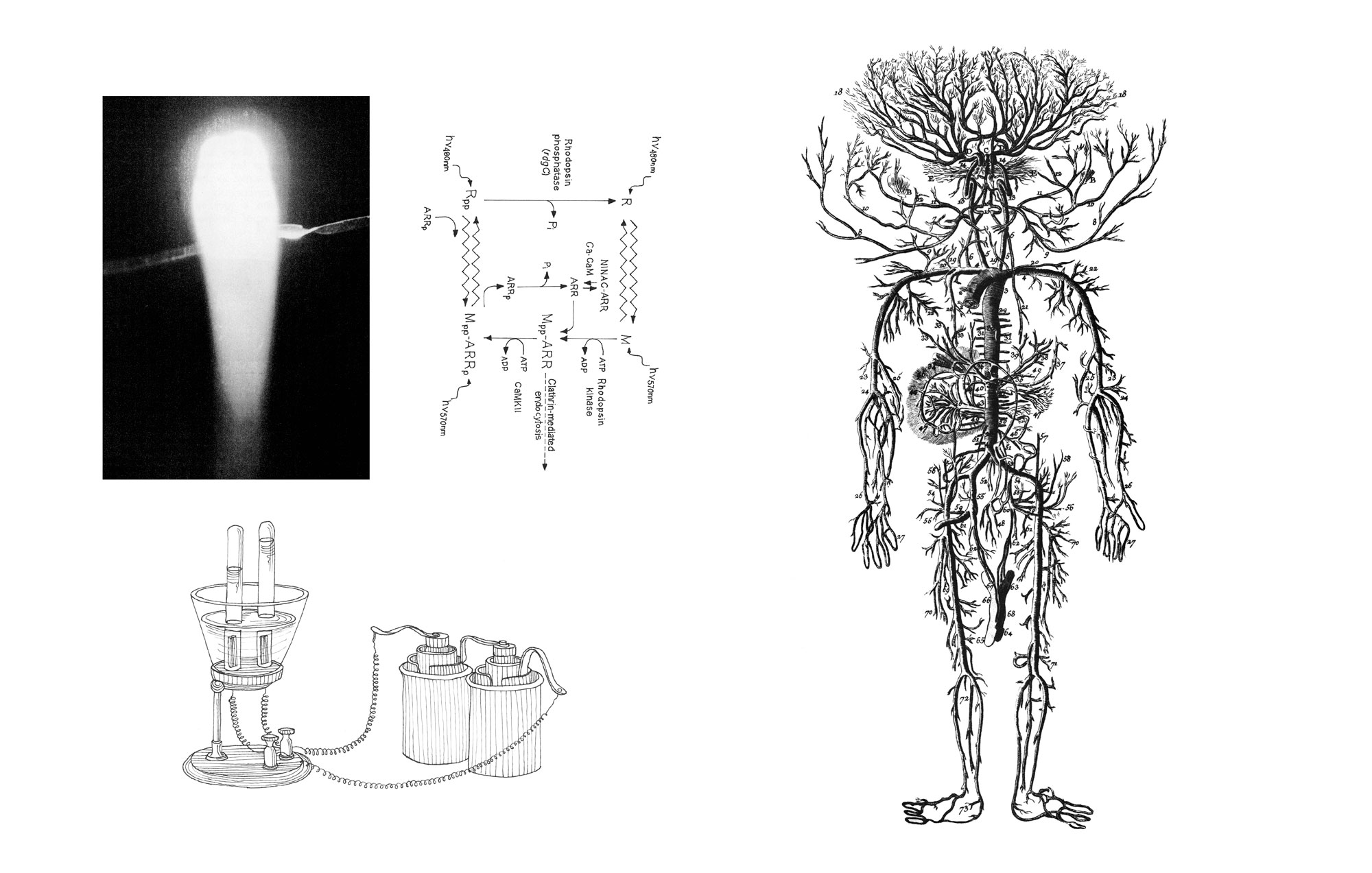XIII
Andrea Galvani © Study on Night Vision for N-1
Hand-drawn and graphic reproductions of archival material, 2006
Pencil, graphite, and inkjet print on paper
44 x 28 cm / 17.3 x 11 inches
N-1
N-1, mathematically speaking, denotes the geometrical function of a curved line plummeting towards zero without ever getting there—the infinite fall. “Life,” wrote Xavier Bichat “is the totality of those functions which resist death.” It is perhaps more of a challenge to define life on its own terms. Theories seem to slow its pulse. N-1 (2006-2008) focuses instead on chemical transformations, anatomical changes, bodies stretched to their conceptual limits—life stripped down to physical processes, somatic mechanisms, and biological breakdowns.
When seasonal temperatures begin to drop, the Lepre variabile, a specific species of rabbits native to parts of the North, change the color of their fur, transitioning from black to white in order to camouflage themselves in landscapes blanketed by snow. An iridescent optical tissue, tapetum lucidum, in the eyes of certain animals increases the availability of incoming light to the retina, allowing them to see frequencies that are non-visible to humans. It also affords superior night vision, causing the pupil to glow in a way similar to the Moon. In N-1 subjects are ethereal, insubstantial substances: matter in the midst of metamorphosis; or petrified, fossilized in a state of stillness. Objects and creatures enshrouded in their own disappearance.
Andrea Galvani © N-1 #1, 2007
C-print mounted on aluminum dibond
Black wood frame
120 x 150 cm / 47.2 x 59 inches, unframed
Andrea Galvani © Study on Photoreceptors for N-1, 2006
Hand-drawn and graphic reproductions of archival material
Pigment liner, pencil, and inkjet print on paper
44 x 28 cm / 17.3 x 11 inches
Andrea Galvani © N-1 #5, 2007
C-print mounted on aluminum dibond
White wood frame with museum glass
139 x 189 x 6 cm / 54.7 x 74.4 x 2.4 inches
Andrea Galvani © 2006
Study on Morphology and Optics for N-1
Hand-drawn and graphic reproductions of archival material
Pencil, graphite, and inkjet print on paper
22 x 28 cm / 8.7 x 11 inches
Andrea Galvani © 2006
Study on Lepre variabile #3 (Skeletal Morphology)
Pencil and graphite on paper
44 x 28 cm / 17.3 x 11 inches
Andrea Galvani © 2008/2018
Study on Walter Russell (1871-1963): Elements of Matter
6500K neon, cobalt blue blown glass
Approx. 250 x 260 x 8 cm / 98.4 x 102.4 x 3.1 inches
Andrea Galvani © 2006
Study on Chemical Transformations for N-1
Pigment liner and black-and-white photograph on paper
22 x 28 cm / 8.7 x 11 inches
Andrea Galvani © 2006
Study on Circulatory System for N-1
Reproduction of archival material mounted on tropical wood
Installation detail
Andrea Galvani © La triade di Bichat III, 2008
Site-specific project for Museo di Castelvecchio, Verona
Still detail from video installation
2'31" DVD loop
La triade di Bichat (2006-2008) is a series of site-specific video installations in which quotidian objects are subject to sublime transformations, emerging and disintegrating at different times in different ways. La triade di Bichat III, above, was designed and presented by the artist at Museo di Castelvecchio in Verona, the city where he was born. In the Torre del Mastio, constructed 1375, Galvani projected this single element against the wall at the tower’s second-story landing above a medieval treasure chest. The key to the main door of the museum, lost over the course of its long history, was resurrected as a phantasmagorical object—appearing out of thin air before slowly dissolving back into the architecture like smoke. Addressing experiences of loss and deprivation, La triade di Bichat is an elegy, the release of raw energy.
Andrea Galvani © The Intelligence of Evil #5, 2007
C-print mounted on aluminum dibond
White wood frame
128 x 90 x 6 cm / 50.4 x 35.4 x 2.4 inches, framed





















